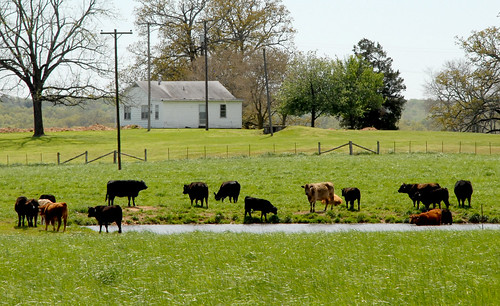Livestock water requirements increase with higher temperatures
By Fred Miller
U of A System Division of Agriculture
July 1, 2016
Fast Facts:
- Summer temperatures drive up water requirements for cattle
- Mature cattle may consume up to 30 gallons per day in summer heat
- Calves require more water per body weight than their mothers
Related website:
http://uaex.uada.edu/publications/PDF/FSA-3128.pdf
(368 words)
FAYETTEVILLE, Ark. — As summer temperatures climb into the 90s, a University of Arkansas System Division of Agriculture animal scientist warns livestock producers that their cattle’s water requirements increase substantially.
Dirk Philipp, associate professor and extension forages specialist, said temperatures in the 90s double or triple cattle water requirements compared to temperatures in the 50s.
Philipp said mature cattle may consume up 30 gallons of water per day in summer heat and, pound-for-pound, calves require more water per their body weight than their mothers.
“Providing fresh water to cattle in these hot temperatures is the most important requirement for keeping them healthy and productive,” Philipp said.
Landowners should plan water access points carefully so that cattle don’t have to travel far to reach it, Philipp said. He recommends taking advantage of city water, if available, because well water may be impaired. If well water is what’s available, he suggests testing it before giving it to animals to be sure it’s safe.
Size of water access points should be large enough to accommodate several animals at once, Philipp said. Otherwise, “lower ranking” animals may not get their share of the water, which could lead to underperformance or even loss of those cattle.
“Water access doesn’t have to be fancy,” Philipp said. “Large tanks or troughs can fit a lot of animals around them, and they can be fitted with shut-off valves that keep them full without running over.”
When using ponds, Philipp said, limit direct access to the pond and route to an off-pond access point. “This protects your pond from bank damage and helps keep the water clean and free of mud,” he said.
More advanced grazing methods, such as rotational grazing, may require more advanced watering systems, Philipp said.
He advises frequent checking of water access during the summer to make sure it is functioning properly. With intense heat, just a couple days without water could spell disaster for a herd.
“Have a backup plan, if possible,” Philipp said, “and diversify your water supply so you can fall back on others if one fails.”
A Division of Agriculture fact sheet offering detailed information about cattle watering systems can be downloaded from the Arkansas Cooperative Extension Service website:
http://uaex.uada.edu/publications/PDF/FSA-3128.pdf
Pursuant to 7 CFR § 15.3, the University of Arkansas System Division of Agriculture offers all its Extension and Research programs and services (including employment) without regard to race, color, sex, national origin, religion, age, disability, marital or veteran status, genetic information, sexual preference, pregnancy or any other legally protected status, and is an equal opportunity institution.
# # #
Media Contact: Mary Hightower
Dir. of Communication Services
U of A Division of Agriculture
Cooperative Extension Service
(501) 671-2126
mhightower@uada.edu
Related Links
